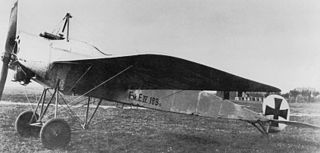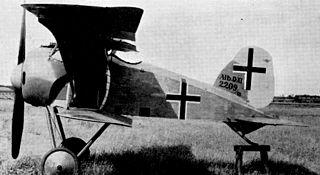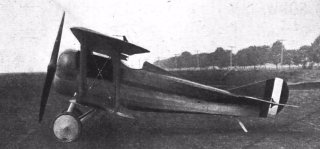The AEG DJ.I was a highly streamlined biplane ground attack aircraft of late World War I that was undergoing evaluation at the time of the Armistice.

The Fokker E.IV was the final variant of the Eindecker fighter aircraft that was operated by Germany during World War I.
Albatros D.VI was the designation given to a prototype single-seat twin-boom pusher biplane built in 1917 in Germany. It was armed with a fixed 7.92 mm (0.312 in) LMG 08/15 machine gun and a fixed 20 mm (0.787 in) Becker Type M2 cannon.

The Albatros D.XI was a German single-seat fighter biplane first flown in February 1918. It was the first Albatros fighter to use a rotary engine, in the form of the 120 kW (160 hp) Siemens-Halske Sh.III, and also featured a new wing construction with diagonal struts from the fuselage replacing traditional wire bracing.

The Pfalz D.VIII was a German World War I fighter aircraft.

The Daimler D.I was a German fighter aircraft of World War I. It was a conventional biplane design with a very small interplane gap - the top wing nearly touched the top of the fuselage. Power was provided by a Daimler D.IIIb water-cooled V-8 engine.

The Hansa-Brandenburg W.19 was a German fighter-reconnaissance aircraft of World War I. It was a single-engined two-seat biplane floatplane, and was a larger development of the successful W.12. It served with the Kaiserliche Marine during 1918.

The LFG Roland D.II was a German single-seat fighter of World War I. The type was manufactured by Luftfahrzeug Gesellschaft, and also by Pfalz Flugzeugwerke under license.
The Schütte-Lanz D.IV was a German fighter prototype during World War I. It was developed in parallel with the Schütte-Lanz D.III, however the two fighters had nothing in common. The D.IV was made of wood and was a single-bay staggered biplane with N-type interplane struts and ailerons on both upper and lower mainplanes. It first flew in late 1917 and was found to be inferior to the Schütte-Lanz D.III, and as a result production was not started.
The Morane-Saulnier AF, also known as the Morane-Saulnier Type AF and the MoS 28 was a French First World War single-seat biplane fighter prototype from 1917.
The Vickers E.F.B.8 was a prototype British twin-engined fighter of the First World War. It was abandoned after only one aircraft was built, single-engined fighters being considered to have superior manoeuvrability.

The Orenco B was a prototype American fighter aircraft of World War I. It was a single-engined, single-seat biplane that flew in 1918. Although it demonstrated good performance, it did not enter large scale service.
The Kondor E 3, sometimes erroneously known as E.III, was a German single seat, monoplane fighter aircraft designed and built close to the end of World War I. Though successful in the third D-type fighter competition at Aldershof in September 1918, only a few were produced, given the Idflieg designation of Kondor D.I.

The Kondor D 6 was a prototype German biplane fighter aircraft flown in 1918. In the interests of better upward vision for the pilot, its upper wing was in two halves, separated over the central fuselage. Its development was soon abandoned.
The Pfalz D.VII was a German biplane fighter aircraft from World War I. It was not put into production.
The Pfalz D.VI was a German sesquiplane fighter aircraft from World War I. It was not put into production.

The Zeppelin-Lindau CS.I was a German single-engined reconnaissance seaplane with a low-wing monoplane layout.

The Kondor D 2 was a German single seat, biplane fighter aircraft designed and built close to the end of World War I.
The Märkische D.I was a prototype single-seat fighter biplane built in the last months of World War I.
The Hansa-Brandenburg W.16 was a floatplane fighter built in Germany during World War I for the Imperial German Navy.










